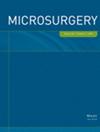Total pharyngolaryngectomy is sometimes combined with total glossectomy for advanced hypopharyngeal or cervical esophageal cancers involving the tongue base. The optimal reconstruction method for total pharyngolaryngectomy with total glossectomy has not been established due to a considerable diameter mismatch between the floor of mouth and the esophageal stump. This report describes two reconstruction methods using free jejunal transfer.
Five consecutive patients who underwent total pharyngolaryngectomy with total glossectomy were included, with a mean age of 67.0 (range 55–75) years. Primary tumors included tongue, hypopharyngeal, cervical esophagus, and laryngeal cancers. The mean defect size was 17.0 (16–19) × 6.8 (6–7) cm. Surgical techniques involved either a simple incision or a two-segment method to address the size mismatch between the jejunum and the floor of mouth. In the simple incision method, a longitudinal cut was made to the antimesenteric or paramesenteric border of a jejunum wall to expand the orifice. In the two-segment method, a jejunal graft was separated into two segments to reconstruct the floor of mouth and the cervical esophagus, and these segments were connected with a longitudinal incision to the cervical esophageal segment to form a funnel-shaped conduit.
Of the five patients, three underwent the simple incision method and two the two-segment method. Postoperative pharyngoesophagography showed a smooth passage for all patients. Postoperative courses were uneventful except for one flap loss due to arterial thrombosis. Four patients achieved oral feeding, while one became gastric-tube dependent. At a mean follow-up of 22.1 (4–39) months, one patient required tube feeding, two tolerated full liquid, and two consumed a soft diet.
Both the simple incision and two-segment methods achieved satisfactory swallowing function. The choice between these reconstruction methods may depend on the extent of resection of the posterior pharyngeal wall.


